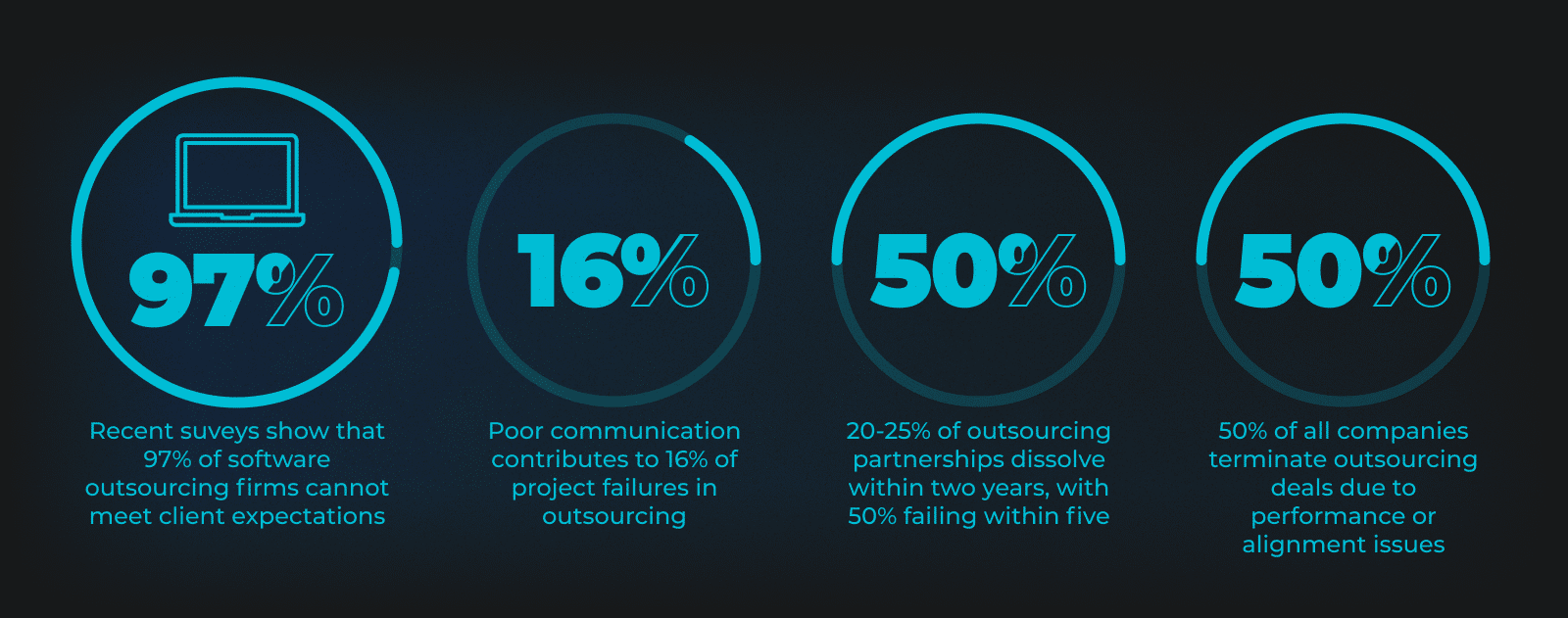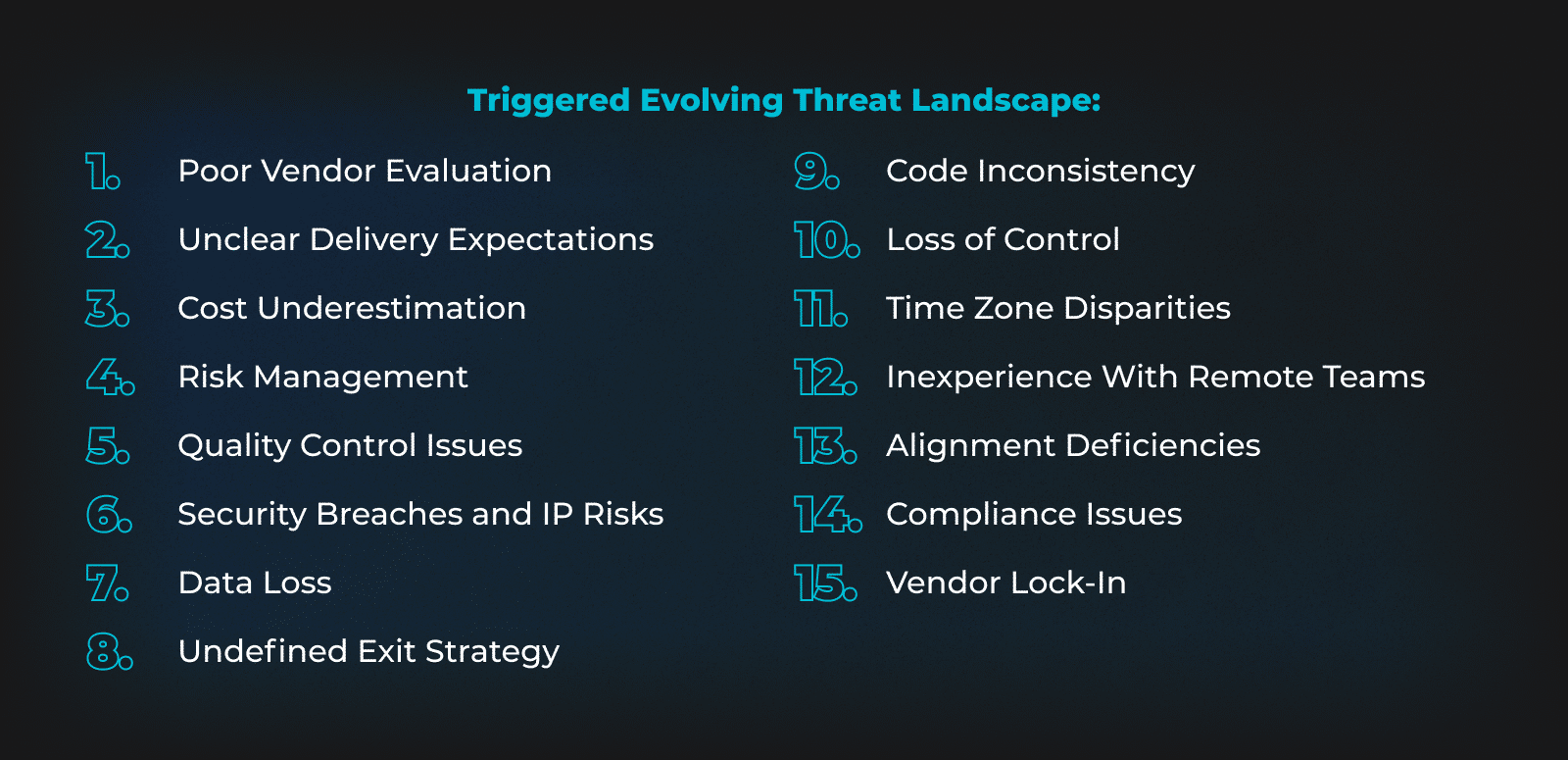Outsourcing Software Development: Common Risks
IT outsourcing is booming, with a forecasted annual growth of 9% leading up to 2030. This surge in popularity is due to its many advantages, such as cutting costs, connecting with elite talent worldwide, and boosting productivity. However, it’s crucial to remember that this strategy has its downsides. And, ignoring the potential risks can spell trouble for your project.

A case in point is the Texas incident. The state outsourced its data center consolidation to IBM, aiming to slash costs and boost efficiency. But, within two years, they were staring at a loss of over $863 million. This story is one of many that highlight the hidden traps of IT outsourcing.
To help you avoid such disasters, this article will highlight the risks that come with outsourcing IT. We’ll also compare outsourcing vs staff augmentation, and highlight why the latter might offer a preferable alternative.
What is IT Outsourcing?
IT outsourcing is the practice of hiring an external company, typically situated in a different city or country, to oversee a company’s IT needs such as software development, technical support, or infrastructure management. It involves relinquishing control of the projects involved to the external party, who may or may not prioritize the company’s interests, potentially leading to delays, security risks, and dissatisfaction among customers or employees.
Top Risks In Outsourcing IT Services
Outsourcing can go wrong for many reasons, from wrong vendor selection to poor project management. Let’s explore these software outsourcing challenges.

Poor Vendor Evaluation
Poor vendor evaluation and selection is one of the primary challenges of software development outsourcing. If, for example, a vendor lacks the essential technical expertise or domain experience necessary for a project, it may lead to subpar deliveries or an inability to meet the project’s requirements effectively. According to one report, 97% of software outsourcing organizations are not qualified to deliver the superior results and outcomes that clients desire.
Unclear Delivery Expectations
A lack of clear project expectations is another of the risks in outsourcing IT services. The requirements for the outsourced software engagement may not be understood and agreed upon by all team members at both companies, likely due to communication difficulties.
This lack of clarity can result in unclear project scope, vague milestones, or differing interpretations of quality standards. Consequently, the project may experience scope creep, missed deadlines, and dissatisfaction from both parties. Poor communication accounts for 16% of outsourced project failures.
Cost Underestimation
Underestimating costs when outsourcing is a common problem that can seriously impact a company’s finances.
While outsourcing often appears to be a cost-cutting measure — 57% of businesses cite it as their primary motivation — failing to consider all expenses involved can lead to overspending. Hidden costs, such as consultant fees, additional resources for project management, or unexpected travel expenses, might not be accounted for in the initial budget. Currency exchange rate fluctuations or inflation are other IT outsourcing risks that can exacerbate the problem of cost underestimation.
If companies do not fully grasp all the costs involved, they might struggle to stay within budget and meet their financial commitments.
Risk Management
Managing risks during outsourcing is a significant challenge for some businesses. The focus is usually on finding the right vendor and negotiating contracts. However, outsourcing goes beyond this. There should be a risk assessment that covers vendor performance and contract compliance, and this must be backed by continuous monitoring to guarantee the efficacy of these measures. Without adequate risk management, businesses may suffer major consequences such as data breaches, legal challenges, negative press, and project failure.
Quality Control Issues
Quality is a key requirement when creating software products. However, quality control issues may arise if development is outsourced to other parties. This can occur as a result of poor communication or disparities in the client and vendor’s standards and procedures.
The fallout from poor quality can range from disappointing minimum valuable products to unhappy customers, higher support expenses, and harm to the brand’s image, ultimately impacting business performance and competitiveness. It’s worth noting that poor-quality software has been estimated to cost the US economy at least $2.41 trillion.
Security Breaches and IP Risks
Outsourcing IT services can make a company’s digital defenses more fragile. When a client entrusts sensitive information and systems to outside parties, the chances of unauthorized access, data breaches, and harmful actions rise. This happens because of poor security measures, weak login protections, or breaches by the outsourcing partner.
These breaches can cause big financial losses, damage reputations, and result in legal issues. But the dangers don’t end there. Outsourcing IT also makes it easier for intellectual property (IP) theft. When outsourcing software development, for example, businesses often share valuable ideas with outsourcing partners. Without solid contracts and non-disclosure agreements, there’s a chance that this IP could be shared or leaked without permission. IP theft alone costs the US anywhere from $225 billion to $600 billion yearly.
Data Loss
Handing over sensitive data to outside vendors raises the risk of data loss. A KPMG study found that in the past three years, 73% of organizations faced major disruptions due to cyber incidents involving third parties. Whether it’s because of human errors, technical issues, or malicious acts, losing or compromising data can cause serious problems. These include financial losses, regulatory fines, and harm to a company’s reputation. Data loss can expose confidential information like customer records or trade secrets, breaking privacy rules and undermining customer confidence.
Undefined Exit Strategy
Outsourcing IT services often requires a long-term commitment, but there are times when the partnership has to end earlier than planned. According to Dun & Bradstreet’s Barometer of Global Outsourcing, about 20 to 25% of all outsourcing relationships don’t last beyond two years, and half fail within five.
The problem is that many outsourcing contracts don’t have a clear plan for ending the partnership. Not having a plan for ending the partnership can make it tough for the company to adjust to changes in business needs, switch to a different provider, or bring important functions back under its control quickly. This is a huge challenge with the outsourcing model.
Code Inconsistency
When outsourcing IT services, inconsistent coding practices can be a problem. Inconsistent coding can cause bugs, security vulnerabilities, and compatibility problems. Poor communication and coordination between dispersed teams can worsen this issue, resulting in differences in coding styles, documentation, and architectural choices.
This can lead to technical debt, making the codebase harder to understand and maintain. It also increases the likelihood of future problems and delays. Technical debt can be rather expensive, with studies showing that, on average, around 25% of all IT budgets are allocated to managing this issue annually.
Loss of Control
Outsourcing software development may mean giving out near-total control over decision-making, resource allocation, and project management to a third-party vendor. For some organizations, this lack of control can be a big problem as it will make it difficult for them to direct the project in the direction of their strategic priorities and goals.
Concerns may begin to arise about whether the vendor or outsourced team is sticking to standards and if the quality stays consistent. These concerns are valid. After all, the client cannot have a sit-down with the developers to look over things.
Juggling time zones, learning company culture, and managing communication hiccups can make it even harder to maintain control, enforce quality standards, and keep the project aligned with business objectives.
Time Zone Disparities
Companies that outsource software development may experience issues due to time zone differences, particularly if the client and vendor are situated in different areas of the world and work at different times. This is one of the popular risks of IT outsourcing. About 36% of business decision-makers worry about the lack of overlapping working hours when considering outsourcing. This concern is valid because it makes scheduling meetings and addressing urgent issues challenging. When one party is available, the other might be outside of regular working hours, resulting in longer response times and reduced productivity.
Inexperience With Remote Teams
One risk of outsourcing software development is the lack of experience with remote teams. This means that the client has never worked with teams spread out in different locations. For companies new to remote work, it can be tough to manage these teams well. Without prior experience or the right tools and processes, coordinating tasks, giving feedback, tracking progress, and keeping the team together can be challenging. This can result in misunderstandings, low morale, less accountability, and ultimately, not getting the best results for the project.
Alignment Deficiencies
One big risk of outsourcing software development is when the company’s goals don’t line up with what the vendor understands. For example, the client may feel that a particular clause in the contract is not favorable, while the vendor insists on having it there. These differences can cause confusion, scope creep, and conflicting priorities. More than 50% of companies end their outsourcing partnerships due to performance or alignment issues, according to Accelerance Global Software Outsourcing Trends 2022.
Compliance Issues
When companies hire teams from different countries or regions to develop software, they may face compliance issues. This means that the team might not follow the necessary laws, regulations, industry standards, or contracts during the outsourcing. Compliance generally covers areas such as privacy policies, ownership rights, security features, and quality requirements. Software development for the healthcare sector, for example, demands compliance with HIPAA guidelines. This is to ensure that the software has special security features that protect sensitive health information. Failure to comply could lead to legal troubles, fines, damage to reputation, and disruptions in operations.
Vendor Lock-In
Vendor lock-in is another of the more common outsourcing risks and typically occurs when a business relies heavily on one outsourcing vendor. Vendor lock-in happens for a few reasons. One reason is if the vendor uses unique technologies or frameworks that are specific to their business. This makes it tough to switch vendors without a lot of extra work.
Another reason is when the software is built with special APIs or integration methods. This makes it hard to connect the software with other systems or platforms. When a business is locked into a vendor, it can’t easily adjust to changes, negotiate better deals, or consider other options. This limits flexibility, innovation, and control over strategies.
How Staff Augmentation Can Mitigate These Risks
IT staff augmentation involves hiring external IT experts or specialists to work temporarily alongside an in-house team. This method, a reliable alternative to IT outsourcing, helps businesses fill skill gaps successfully. Here’s how working with the perfect IT staff augmentation partner could mitigate the risks of outsourcing IT services:
- Control and Oversight: With staff augmentation, organizations have direct control over the development process. This ensures compliance with organizational values, standards, and techniques.
- Flexibility and Scalability: Staff augmentation allows flexible team scaling, preventing resource over-commitment or under-staffing during vital project phases.
- Quality Assurance: Integrating external specialists into the in-house team ensures that the work meets requirements. Companies can implement their development best practices and QA processes, minimizing the risk of poor coding or compatibility issues.
- Cost Effectiveness: Staff augmentation provides transparent pricing models, helping companies accurately budget for needed resources. There are no hidden costs or unexpected charges.
- Cultural Alignment: Augmented staff members blend into the existing team, preserving organizational culture and work practices. This fosters better collaboration and communication, reducing the risk of cultural clashes often seen with outsourcing.
Conclusion
Outsourcing can be a good way to handle software development projects, but it’s important to acknowledge the risks involved. Worried about these outsourcing risks and mitigation techniques? Why not explore IT staff augmentation through Newxel instead?
As one of the top IT staff augmentation companies in the industry, we are well-positioned to help you reduce risks, boost project outcomes, retain control, and promote collaboration. Our augmentation services will enhance efficiency and innovation in your development projects.






